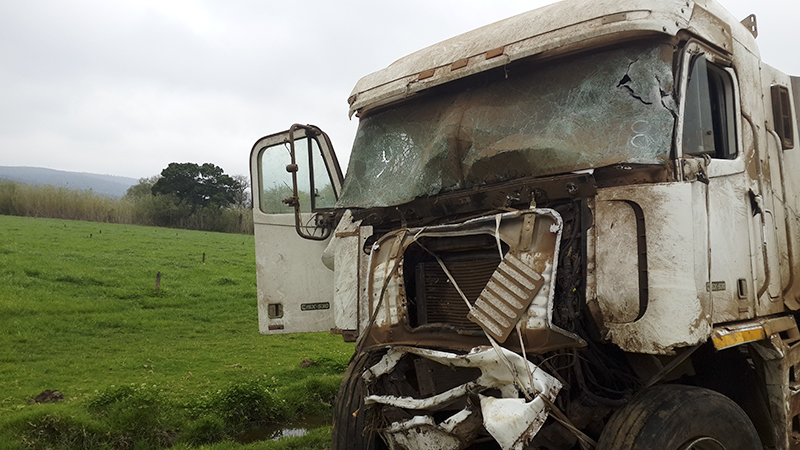Makana says state owned farms and commonage form part of its strategy to deal with stray livestock. This follows the a truck driver’s narrow escape when his 14-wheeler hit cows on the N2 outside Grahamstown recently.
Grocott’s Mail asked Sanral what the extent of their responsibility was when it came to maintaining and securing roads under its stewardship, and whose responsibility it was to keep cattle and other livestock off national roads.
The Agency said they had noted and, where possible, acted on the concerns over wandering livestock on the N2.
“The upkeep and maintenance of the fences is the responsibility of SANRAL, road rangers provided by the Eastern Cape Department of Transport and the land owners of the properties adjacent to the N2,” said Vusi Manager, General Manager Communications: SANRAL “There appears to be little to no responsibility taken by the farmers who own the livestock.”
“Despite continuous efforts by SANRAL’s maintenance contractor to address the issue of wandering livestock by adopting a variety of fencing options in the affected areas, theft and damaging of fencing has been a persistent issue.
“The absence of herdsman to look after the cattle and prevalence of greener grass on the road reserve as compared with the overgrazed farmland adjacent to the road reserve are additional factors that contribute to the cattle roaming freely.”
Manager said Sanral would like to encourage the local communities in which it worked to protect fences erected to keep animals off the road and further prevent accidents such as the ones reported from happening again.
“It should also be strongly noted that as owners of the cattle which caused the accidents that they are liable for prosecution,” he said.
Manager urged motorists to exercise caution when driving on those sections of the freeway and to adhere to the speed limit.
Bylaws
Civil society organisations the Grahamstown Residents Association and Grahamstown Business Forum both put the problem at the municipality’s doorstep.
“Whether it’s piles of rubbish, overflowing sewers, or unbranded livestock, Makana is risking the health and lives of residents by not doing what they are legally obliged to do,” the GRA said in a statement after the N2 incident.
“Makana does face challenges because of anti-social residents dumping, vandalising and ignoring rules, but that does not excuse officials who have walked away from managing problems and make no attempt to apply their bylaws. Things need to change, and Grahamstown needs good leadership and communications to do so.”
The GBF said until Makana enforced its bylaws, stray livestock would continue to cause irreparable damage to the environment and cause road traffic accidents.
“I understand that animals may stray on to the road even with the best of fences,” said chairperson Richard Gaybba. “However, the reason in Makana is directly because of the lack of political will to enforce the bylaws and resolve the issue.
“How many people need to be maimed and killed before action is taken? It’s about time that those who are responsible are held accountable for their actions or lack thereof.”
Commonage
Makana Parks and Recreation Manager Jeff Budaza says state owned farms and commonage form part of Makana Municipality’s strategy to deal with stray livestock.
An audit of seven state-owned farms in the area is under way – an exercise being undertaken jointly by the LED Department’s Agriculture Manager Piwe Gqweta and Budaza.
There are three categories of emerging farmers, Budaza explained:
* Land claimants
* Tenants on municipal farms
* People who live in the township but own cattle
“The difficulty has beentrying to identify a legitimate stock owners or farmers association,” Budaza said.
A person had identified herself as secretary of the Makana Emerging Farmers Association – but none of the emerging farmers knew of it or identified themselves as members, making it difficult to form a Commonage Committee.
“There are seven state owned farms and the people living on them occupy crucial positions – but there are seven separate structures for the seven farms – with no co-ordinating body,” Budaza said. “This makes it a real challenge to organise them.”
Township cattle owners were easier to identify and manage.
“We have identified five or six families who own the cattle in town,” Budaza said. Called to a meeting at BB Zondani Hall last week, they said more rangers were needed to keep livestock in the town under control.
Asked to respond to the recent N2 incident, Budaza said he’d been to inspect the site.
“You can’t say those cattle come from town,” Budaza said. “In my opinion those cattle are not from Xolani – cattle from there don’t wander that far. They are more likely to belong to one of the farmers in the area, or one of the farmworkers.”


